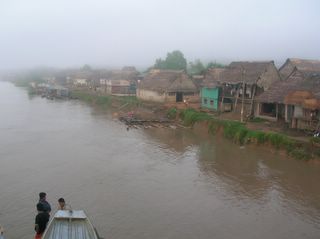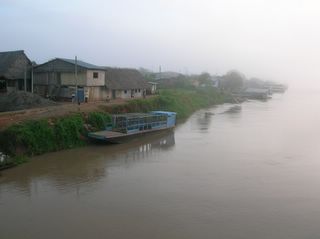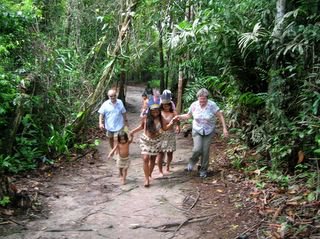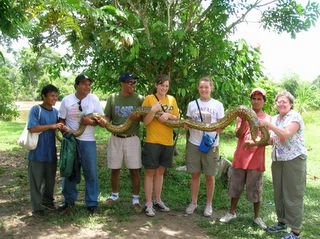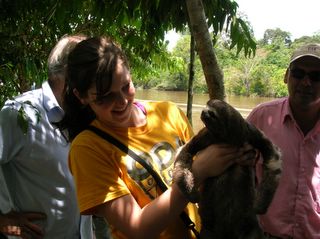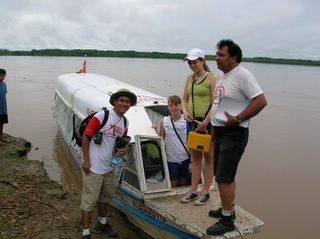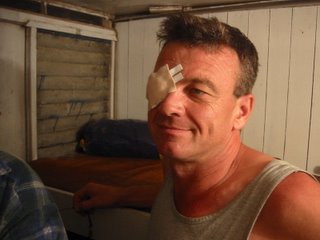
Surviving The Amazon
Culturally there are a few differences that you should all be aware of and with a little bit of preparation you can avoid culture shock, either yours or there’s. It’s should be your goal to be a blessing to your Peruvian brothers and to avoid offending them inadvertently.
Peruvians tend not to be loud in the public arena. To yell across the street at someone would be considered rude. A Peruvian would just hold up a hand and wait till they are noticed. In general the pushy out-going nature of most Americans is not considered good manners there. Women are very reserved and take a subservient role in public. At the same time, they tend to be stronger leaders in the family and church. If you have a tendency to take charge and tell others how things should be done, then you will have to moderate and sit back much more than you are use to.
Please also note; to go with an agenda, will lead to great frustrations. Nothing goes according to schedule in South America. Ferry’s run late; if they even have a schedule at all. Meeting times are usually approximate, church services go until God is finished and dinner, is, when its served. It may just be, that we accomplish nothing that we plan, and God has a different goal for us through this trip.
We will be going to Peru to serve and encourage, not to lead. Nothing that we take with us as gifts or accomplish has anything to do with our works or talents. We have not given, God has. Everything that is done, is done by God, and for God.
Worship in the jungle church tends to be on the Pentecostal side. Its not that they do anything Really odd, or would make a conservative evangelical feel uncomfortable, but it is much more alive and interactive. When we first participate in the worship, our hosts may think we are very exhausted or dead spiritually. The people clap more enthusiastically, smile more, sing louder, and bounce more. The services last as long as God is leading. There may seem to be no order of worship. We may start with song then give testimonies, sing, more testimonies, preach, sing whatever. We will be done when God is done. The church there tends to be much more open to the leading of the Holy Spirit and less to the schedule of man.
Everywhere we go we will be recognized as Americans. Therefore, it is naturally assumed that we are rich. By Peruvian standards we are; but, with that comes the chance that you will be asked for money; maybe even from the leadership of the church. Please be careful here. Ask me before giving anyone anything. When we leave we will take an offering for the church that will be distributed by the mission as they see best. We already pay some of our hosts for the time that they devote to us, as they have taken time off of raising money for their families to serve us. When they take offering at church, use the leading of the Holy Spirit as what would be appropriate. The people we are working with make about 200.00 usd per month, and the prices of things are close to the same as in the USA. The appropriate tithe maybe 5.00 usd or 15 soles (The Peruvian dollar). Never pull out large sums of money in pubic, be discreet, our hosts will help us in the exchange of money and various purchases. Gringos normally are charged more, so ask before making any deals.
If you have not paid the full amount to JungleMaster for the trip, be prepared to cover the costs of food and transportation as we go. We have estimated that we will spend about 2000.00 for food, rentals and boats. Lastly you must have 25.00 USD in cash to leave the country as an exit tax.
IQUITOS
Iquitos is a large city of about 200,000 people. It is land-locked, with impenetrable jungle surrounding it, the only way to get there is by boat or airplane. Yet it is the hub of commerce in the Peruvian Amazon. Iquitos has a rich history dating back to the 1800s when it was the center of the world for rubber exports. European aristocracy would make the trip up the Amazon to Iquitos and vacation there. Iquitos is 2500 miles from the mouth of the Amazon by boat, and at 725 feet in elevation. Today, Iquitos still remains a frontier town that is working at becoming the hub for Ecotourism in the Amazon.
Food And Safety
Malaria meds are recommended, mefloquine is the meds for South America, but you may consider this; http://www.organic-pharmacy.com/ARG.Artemesia.htm you should also think about yellow fever vaccination, Hep-A, and Hep-B. The people we will be with feel that these are very rare diseases and we would be fine with out them. But I don’t want to be the final word on your health. Ask your doctor.
CDC recommends the following vaccines (as appropriate for age):
See your doctor at least 4–6 weeks before your trip to allow time for immunizations to take effect.
• Hepatitis A or immune globulin (IG).
• Hepatitis B, if you might be exposed to blood (for example, health-care workers), have sexual contact with the local population, stay >6 months in the region, or be exposed through medical treatment.
• Rabies, if you might be exposed to wild or domestic animals through your work or recreation.
• Typhoid, particularly if you are visiting developing countries in this region.
o Occurrence
An estimated 16 million cases of typhoid fever and 600,000 related deaths occur worldwide each year. Approximately 2.6 cases of typhoid fever were reported to the Centers for Disease Control and Prevention per 1 million U.S. citizens and residents traveling abroad during the period 1992–1994.
Risk for Travelers
Typhoid vaccination is not required for international travel, but it is recommended for travelers to areas where there is a recognized risk of exposure to S. Typhi. Risk is greatest for travelers to the Indian subcontinent and other low-income countries (in Asia, Africa, and Central and South America) who will have prolonged exposure to potentially contaminated food and drink. Vaccination is particularly recommended for those who will be traveling in smaller cities, villages, and rural areas off the usual tourist itineraries. Travelers should be cautioned that typhoid vaccination is not 100% effective and is not a substitute for careful selection of food and drink.
• Yellow fever vaccination, if you will be traveling outside urban areas.
o The risks of illness and of death due to yellow fever in an unvaccinated traveler are estimated to be 1:1,000 and 1:5,000 per month, respectively. (For a 2-week journey, the risks of illness and death are 1:2,000 and 1:10,000, respectively.) These estimates, which are based on risk to indigenous populations, may overestimate the risk to travelers, who may have a different immunity profile, take precautions against getting bitten by mosquitoes, and have less outdoor exposure than do indigenous residents. Based on data for U.S. travelers, the risk for illness in a traveler due to yellow fever has been estimated to be 0.4–4.3 cases per million travelers to yellow fever-endemic areas.
• As needed, booster doses for tetanus-diphtheria and measles. Hepatitis B vaccine is now recommended for all infants and for children ages 11–12 years who did not complete the series as infants.
To stay healthy, do...
• Wash hands frequently with soap and water. Don’t bite your finger nails.
• Drink only bottled or boiled water, or carbonated (bubbly) drinks in cans or bottles. Avoid tap water, fountain drinks, and ice cubes. If this is not possible, make water safer by BOTH filtering through an “absolute 1-micron or less” filter AND adding iodine tablets to the filtered water. “Absolute 1-micron filters” are found in camping/outdoor supply stores.
• Eat only thoroughly cooked food or fruits and vegetables you have peeled yourself. Remember: boil it, cook it, peel it, or forget it.
• If you will be visiting an area where there is risk for malaria, take your malaria prevention medication before, during, and after travel, as directed. (See your doctor for a prescription.)
• Protect yourself from mosquito bites:
o Pay special attention to mosquito protection between dusk and dawn. This is when the type of mosquito whose bite transmits malaria is active.
o Wear long-sleeved shirts, long pants, and hats.
o Use insect repellents that contain DEET (diethylmethyltoluamide).
o Read and follow the directions and precautions on the product label.
o Apply insect repellent to exposed skin.
o Do not put repellent on wounds or broken skin.
o Do not breathe in, swallow, or get into the eyes (DEET is toxic if swallowed). If using a spray product, apply DEET to your face by spraying your hands and rubbing the product carefully over the face, avoiding eyes and mouth.
o DEET may be used on adults, children, and infants older than 2 months of age. Protect infants by using a carrier draped with mosquito netting with an elastic edge for a tight fit.
• To prevent fungal and parasitic infections, keep feet clean and dry, and do not go barefoot. .
To avoid getting sick...
• Don’t eat food purchased from street vendors.
• Don’t drink beverages with ice.
• Don’t eat dairy products unless you know they have been pasteurized.
• Don’t handle animals (especially monkeys, dogs, and cats), to avoid bites and serious diseases (including rabies and plague .
Your major threat will be bug bites. The tics and chiggers are in the grasses and rocks everywhere. One team member had over 300 individual bug bites on just their legs. I have yet to find anything that is real effective to stop from getting bit. .
.
Do not jump into any water or swim unless the local people say that is a safe place to swim. Don’t urinate in the water. There are fish that will be attracted to your urinary track if you do. Don’t wander into the jungle alone. Don’t put your hands into anything that you can’t see into first. Open and inspect clothes and bedding before putting on or getting into. Look were you put your feet when in the jungle, be aware and you will be safe. Keep your food and bedding closed and zipped. Be careful around the water at night, some types of snakes come out then.
Watch the locals and do as they do and you will be safe. This may seem like a lot of dos and don’ts but these are things that I have learned from my trips to the Amazon and with a little fore warning we will all be that much more safe and comfortable.
Sunscreen with the highest protection factor possible and deet type insect repellant must be applied daily and often. Bring your own. Insect bite cream or anti ich cream should also be brought with you.
I always keep a supply of protein / food bars with me. I take enough to have two a day. Buy some now and test out the kinds you like. It helps you keep control of your stomach and less reliant on people to prepare food for you. If you control your stomach everything else will work out.
What you need to bring with you:
• Long-sleeved shirt, long pants, and a hat to wear while outside whenever possible, to prevent illnesses carried by insects (e.g., malaria, dengue, filariasis, leishmaniasis, and onchocerciasis).
• Insect repellent containing DEET.
• Over-the-counter antidiarrheal medicine to take if you have diarrhea.
• Iodine tablets and water filters to purify water if bottled water is not available. See Do’s above for more detailed information about water filters.
• Sunblock, sunglasses, hat.
• Prescription medications: make sure you have enough to last during your trip, as well as a copy of the prescription(s).
• Voltage is 220 v so bring adapters if you need to.
• After You Return Home:
If you have visited an area where there is risk for malaria, continue taking your malaria medication weekly for 4 weeks after you leave the area. If you become ill with a fever--even as long as a year after your trip--tell your doctor that you traveled to a malaria-infected area
The primary thing is being careful. I never eat anything that’s not Hot. Unless I just picked it off a tree or have just prepared it myself. Water must only be put in your mouth if it was bottled or purified. We will ensure a good water supply for everyone at all times. You should have at least two Nalgean type water bottles; Always keep them full and with you. It will be very hot and extremely high humidity. If you get thirsty you are already dehydrated. You will drink a gallon of water a day or more in these conditions. Never open your mouth in the shower or brush your teeth from the tap water or river water. Drink soda from the bottle; do not use ice or the glass unless you are in a North American ready restaurant. In Lima and Iquitos we will be able get safe reliable food and water but in the jungle it gets a little harder
When in the city be careful as to how you handle money and your gear. You average camera is worth a years wages in many parts of the world. Put it in your pocket when not in use. Keep only the money you may spend for the day in your wallet or pocket, if you get robbed you will only lose a little. I keep my wallet as a toss-wallet, nothing more than a few dollars and things that I can live without. My Passport and my money I keep in a waist pouch. I never take it off. Your US Passport is worth $10,000 on the open market, never lose it or let someone have it. Keep a copy of it in another place in case it gets lost. I take a copy of mine and E-mail it to help@junglemaster.org. That way; I can get a copy anytime from anywhere in the world. Just be aware that many things we do flaunt our affluence, and invite being robbed.
You will NOT need a visa, but you will need a Passport.
Equipment
You will need a backpack that you can put everything you own in. Rolling a piece of standard luggage won’t work in the jungle. Have all your stuff in bags with handles or backpacks. When we get to the villages in the jungle you may have to pack your gear ½ mile or so at times and you will want to be able to throw on one pack and go. One pair of socks and underwear per day that are fresh, T-shirts or loose fitting shirts are a must. Nothing heavy, Dry-leet or similar fast drying materials are recommended. In the jungle we will not be able to get anything dry. Everything will be damp and sticky, tight underwear will chafe and glue to your rear end. Put socks and underwear in plastic zip lock bags. Anything that can’t get wet should be protected. You will need a towel and washcloth. We will be bathing in the river in the jungle. A super light poncho is good to have or you can go Indian style: Get wet and let the sun dry you off. If it rains while we are in the canoes EVERYTHING will get wet. Everything in the backpacks that should be dry must be protected from water and rain
Sun precautions Again: We will be on the equator, burns happen instantly, a hat, sunglasses, sunscreen are your friends.
ALWAYS have toilet paper with you. I keep some of those small packs of tissues in my pocket. Only in nice, North American friendly restaurants or hotels will you find toilet paper. It’s just not around anywhere else. Public restrooms are available in the cities but you won’t find T.P. there. In the jungle, it will be a matter of hovering over two boards over a hole in the ground. There may or may not be any screen around that hole. I am looking into a portable privacy screen that we can take with us
You will need a hammock with a built in bug screen. They can be found at Campmor http://www.campmor.com/webapp/wcs/stores/servlet/
ProductDisplay?memberId=12500226&productId=39148948
Or
http://www.campmor.com/webapp/wcs/stores/servlet/
ProductDisplay?memberId=12500226&productId=7568
Clark Hammock
http://www.junglehammock.com/features.php
If you are on the ferry or in huts we can always hang a hammock up. In the city you will have real beds. Sleep in the hammock once before you take it to the jungle. There is a trick to how taut they need to be. Bring a fleece type or ultra light sleeping bag. You need the protection from mosquitoes, they will get you through the hammock into your rear unless you have that extra layer. In the mornings it will seem cool and the bag will feel good to curl up in.
A good alternative is a small tent that can free stand, you will want a pad as jungle huts have bamboo round poles as flooring and its hard on your back.
Bring
• Backpack
• Flashlight
• Hammock or alternative
• Plastic bags for your gear
• Toilet paper
• Proper clothing
• Sleeping bag, Very light fleece is OK
• Any special needs (meds ect)





